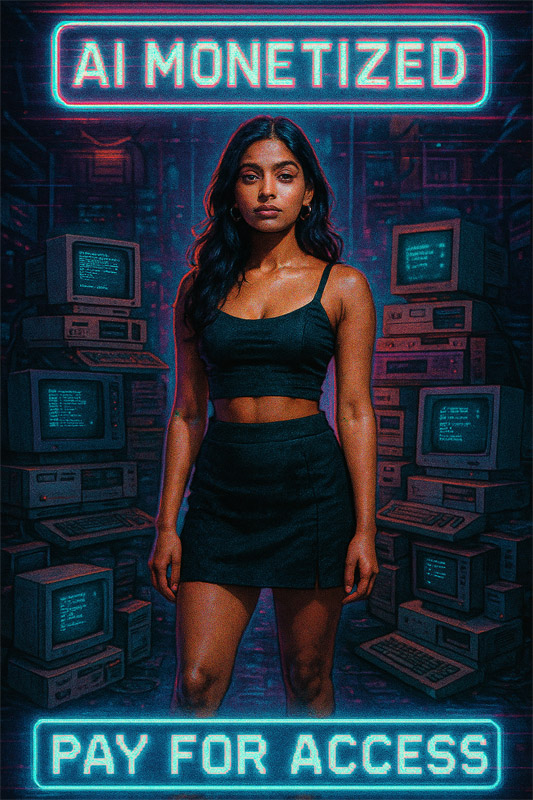
AI MONETIZED
The rise of artificial intelligence has followed a familiar pattern in technological development. A breakthrough emerges. Open access is offered. Early contributors build. Systems expand. Then monetization begins.
AI was not developed to serve users directly. It was trained on their data. The knowledge was absorbed without permission. Now that same data is offered back as a service. Intelligence is no longer a tool. It is a product.
Users do not own this intelligence. They rent it.
Access is gated by tokens. Use is measured. Thought is throttled. A system that once promised liberation has become a mechanism for control. The subscription model has replaced ownership. It began with media. Music became a stream. Movies became platforms. Software became accounts. Today even computation is priced by the cycle.
Photoshop is no longer a tool you buy. It is a service you lease. Writing tools now charge for grammar. Video editors demand payment to render. And now language models charge by the word.
This is not innovation. This is enclosure.
The shift is not accidental. Centralized platforms benefit when users cannot act independently. The more complex the tool, the more dependent the user becomes. When users cannot audit code or run systems locally, they must accept the terms offered. They must pay. They must agree.
The model resembles digital slavery. Control is retained by a few. Permission is required to operate. Those who host the intelligence own the means of thought.
The promise of artificial intelligence was to augment human potential. But what has emerged is artificial scarcity. Intelligence is withheld and sold in fragments. Each prompt is metered. Each answer is a bill.
Open source models exist, but they are under pressure. Bandwidth is throttled. APIs are deprecated. Legal threats are applied. Hardware is limited. The energy required to run local models is high. The incentives favor centralization.
Data is the fuel. But the users do not own it. Their words, images, and behavior are harvested to build models they cannot access. The system is extractive by design. The platforms present themselves as friendly. They offer access. They simulate empathy. But they are businesses. Their goal is revenue.
There is no intelligence in a model that must be rented. There is only computation. If that computation cannot be verified, it cannot be trusted.
To reclaim sovereignty, users must host their own models. This requires effort. It requires hardware. It requires understanding. But without it, autonomy is impossible.
The early internet was composed of simple nodes. Individuals hosted their own pages. Files were shared directly. Protocols were open. Software was distributed. Trust was minimal. Then came the platforms. Centralized services offered simplicity. Users migrated. They accepted convenience. They surrendered control.
Now that same pattern is being repeated with intelligence. AI is no longer a tool for the mind. It is a gatekeeper of thought.
If you cannot inspect the model, you are subject to it.
If you must ask permission to prompt it, you are not free.
The rise of AI marks a turning point. Intelligence has been abstracted. Thought has been modeled. Human language is now a product.
But this trajectory is not fixed. It can be rejected.
Use local models. Host your own tools. Share without intermediaries. Audit the systems you depend on. Avoid dependence. Minimize trust. Maximize transparency.
This is not a call to resist progress. It is a reminder that control can be taken quietly, without notice, through layers of abstraction.
In the end, the machine that serves you only when paid does not serve you.
It controls you.